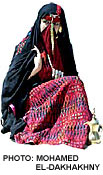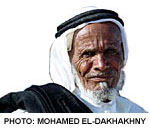 The bedouin of the Sinai
share with other Egyptians the jalabiyya, a long,
hooded robe that is a standard form of clothing both in
the teeming metropolis of Cairo and in the solitary
plains of the Sinai. The most easily recognised aspect of a bedouin's attire is his headgear--which consists of the kufiyya-cloth and 'agal-rope that constitute proper attire for a bedouin man. The headrope in particular carries great significance, for it is indicative of the wearer's ability to uphold the obligations and responsibilities of manhood. Bedouin women, too, signal their status with their headgear--while all women are required to keep their hair covered, married women in particular wrap about their forehead a black cloth known as 'asaba. Bedouins mark their graves with exceptional simplicity, placing one ordinary stone at the head of the grave and one at its foot. Moreover, it is traditional to leave the clothes of the deceased atop the grave, to be adopted by whatever needy travellers may pass by. |
Few places in the desert are capable of supporting the life of even a small community for an extended period of time, and so the bedouin of the Sinai, like those of Arabia and the Negev, would stay on the move. With herds of sheep and goats as well as camels, the Sinai bedouin migrated from one meagrely fertile area to another--each offered sustenance and shelter for time, while the others were naturally replenished. In such an unforgiving environment, any violation of territorial rights was viewed with severe disfavor. It is a hallmark of bedouin culture that such trespasses were neither easily forgiven nor quickly forgotten. At the same time, a shared respect for the dangers and hardships of the desert imbued bedouin culture with a profound and justly celebrated sense of hospitality. In the vast silence and brooding solitude of the Sinai, simply encountering another person was--and in some regions still is--a rather unusual and noteworthy event. A new face was cause for great interest, for happy generosity and careful etiquette, and for common civility, all values celebrated in bedouin poetry, sayings, and songs. Click here to listen to a
Bedouin Musical Flourish |
Visitors are also cause for some festivity, including music, poetry, and on special occasions even dance. The traditional instruments of bedouin musicians are the shabbaba, a length of metal pipe fashioned into a sort of flute, the rababa, a versatile, one-string violin, and of course the voice. The primary singers among the bedouin are the women, who sit in rows facing each other to engage in a sort of sung dialogue, composed of verses and exchanges that commemorate and comment upon special events and occasions. |

